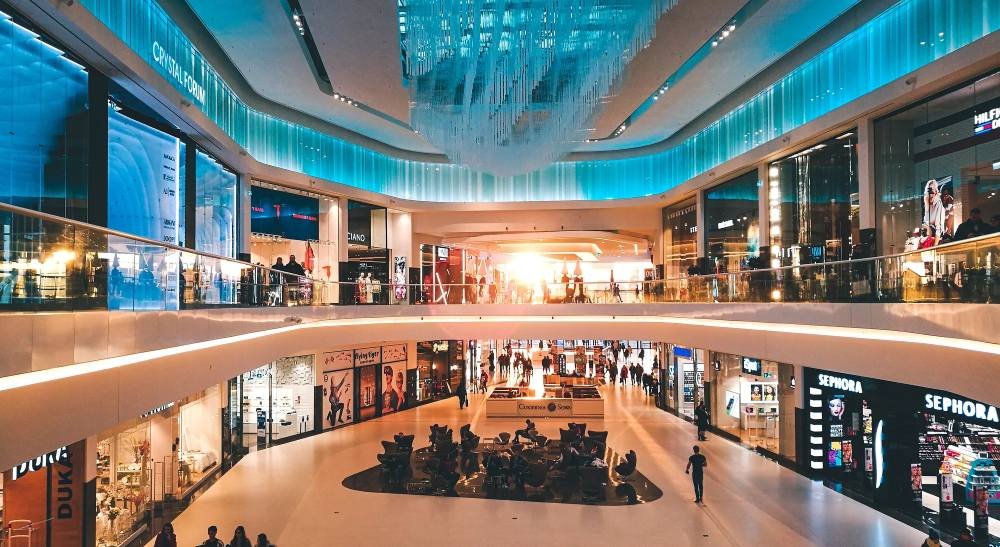
The Role of Augmented Reality in Future Shopping Centers
Imagine walking through a mall where products leap from their displays, digital assistants guide your path, and mirrors double as personal stylists. This isn’t a scene from a science fiction movie, it’s the near future of retail, and at the heart of it lies one transformative technology: Augmented Reality (AR).
What Is Augmented Reality in Shopping Malls?
Augmented reality (AR) overlays digital content onto the real world through devices like smartphones, AR glasses, or digital screens. In shopping malls, AR creates immersive, interactive experiences that blend physical and digital shopping environments. It enhances how customers discover products, try on items virtually, navigate stores, and interact with brand content.
Unlike virtual reality, which fully immerses users in a digital environment, AR keeps the physical world in view while adding computer-generated elements to it, like animations, images, videos, or 3D models. In malls, this might mean scanning a product to see reviews pop up on your phone, standing in front of a mirror that lets you “try on” clothes without changing, or navigating the mall with digital arrows guiding your path.
AR in shopping malls isn’t just a novelty, it’s a strategic evolution in the retail experience. It drives engagement, reduces friction in the buying process, and caters to a generation of digital-native consumers who crave both convenience and interactivity.
From Window Shopping to Digital Dressing Rooms: A New Era Begins
The way people shop has always been influenced by culture, technology, and lifestyle. From the open-air markets of ancient cities to the grand department stores of the 20th century, retail has consistently adapted to consumer needs. Now, as online and physical retail continue to blend, augmented reality is taking center stage in transforming the traditional shopping mall.
Imagine this: You walk into a shopping center. Instead of wandering aimlessly or consulting a static map, you pull out your phone and scan a QR code. Suddenly, a virtual assistant appears on your screen. With a friendly smile, she offers to guide you to the latest deals, help you locate the perfect pair of shoes, or even summon an AR model of a dress you were thinking about.
As you walk by the storefront of a high-end fashion outlet, you notice an interactive display. It invites you to “try on” the season’s latest looks, virtually. Within moments, you’re looking at your own reflection, dressed in clothes you haven’t physically touched yet. You swipe through different outfits, adjust colors, and instantly share the looks with friends for feedback.
This isn’t far-off fantasy, it’s the direction shopping malls are heading, thanks to augmented reality.
How IKEA Uses Augmented Reality: A Case Study
No discussion of AR in retail is complete without highlighting IKEA, the global furniture giant that has become a pioneer in immersive shopping experiences.
The IKEA Place App
IKEA’s AR journey began in earnest with the launch of the IKEA Place app in 2017. This mobile application uses Apple’s ARKit and Google’s ARCore to let users virtually place furniture in their own homes using their smartphones or tablets. Customers simply scan their environment, pick a product from the app’s catalog, and drop it into the real-world scene on their screen. The result? A to-scale, photo-realistic visualization of how that IKEA couch, table, or shelf would look in their living room.
This innovation solved a major pain point for customers: uncertainty. No more wondering if that armchair is too bulky or if the rug clashes with your decor. With AR, the guesswork is removed, and customers are more confident in their purchases, which reduces returns and boosts satisfaction.
AR Integration In-Store
IKEA has also experimented with AR experiences in-store. For instance, some IKEA locations offer digital kiosks where customers can scan products and view them in their homes via AR before buying. Others use AR to create interactive room design simulations, helping customers visualize entire spaces furnished with IKEA products.
The success of IKEA’s AR initiatives has not only enhanced the customer experience but has also reinforced the brand’s image as innovative, forward-thinking, and customer-centric.
Examples of Augmented Reality in Retail
While IKEA is a standout, it’s far from alone. Across the globe, retailers in diverse sectors are embracing AR to deliver unique, value-added experiences.
1. Sephora: Virtual Try-Ons
Cosmetics retailer Sephora uses AR to help customers try on makeup virtually. Through its “Virtual Artist” feature in the Sephora app, users can see how different lipsticks, eye shadows, and foundations look on their face using their phone’s camera. This has been especially popular during and after the COVID-19 pandemic, when physical try-ons were limited.
2. Nike: Virtual Shoe Try-On
Nike’s app includes an AR feature that lets users point their phone at their feet and try on different shoe styles. The app measures the foot and displays how various shoes will look and fit. This isn’t just a fun gimmick, it helps customers pick the right size, reduces returns, and deepens brand loyalty.
3. Zara: Interactive Storefronts
Fashion giant Zara experimented with AR in several flagship stores by replacing mannequins with AR experiences. When customers pointed their phones at certain store windows or displays, they could see models wearing the clothing in motion, even on the sidewalk outside the store. These virtual models showcased how the garments flowed, moved, and paired with other items, creating a dynamic display far more engaging than a static mannequin.
4. Lowe’s: Home Improvement in 3D
Home improvement store Lowe’s launched an AR tool called “View in Your Space” that allows users to see appliances, furniture, and fixtures in their own home. Lowe’s has also tested in-store AR wayfinding, helping customers locate items on their shopping list through their phones or smart glasses.
How AI and AR Work Together in Shopping Malls
Augmented reality is powerful on its own, but when combined with artificial intelligence (AI), its potential multiplies. AI adds intelligence, personalization, and predictive capabilities to the AR experience.
1. Personalized Recommendations
AI can analyze user behavior, preferences, and past purchases to offer personalized AR experiences. For example, as a customer browses clothing in a mall, an AR screen could suggest outfit combinations based on their past purchases or current trends. AI-driven insights enhance AR’s interactivity with relevance and context.
2. Smart Navigation and Wayfinding
AI helps power intelligent AR navigation. In future malls, shoppers may use AR glasses or smartphone apps to receive turn-by-turn directions to the nearest restroom, cafe, or specific product. AI algorithms can calculate the fastest routes, account for crowd density, and adapt in real-time to obstacles.
3. Virtual Assistants
AI-powered chatbots or avatars can appear within AR interfaces to assist customers. These digital helpers can answer questions, provide product details, help with checkout, or escalate to a human associate if needed. With natural language processing, these assistants can engage in realistic, human-like conversations.
4. Inventory Management
Behind the scenes, AI algorithms analyze data from AR interactions to optimize inventory. If a virtual try-on display reveals that a certain jacket is getting high engagement but low purchase conversion, managers can adjust pricing, restocking, or product placement accordingly.
The Benefits of AR in Future Shopping Centers
Augmented reality in shopping malls isn’t just about cool tech, it’s about solving real problems and elevating the customer experience. Here’s how:
1. Enhanced Customer Engagement
AR makes shopping fun and interactive. Gamified promotions, digital scavenger hunts, or selfie stations using branded AR filters can make a trip to the mall a memorable event. This engagement builds emotional connections with brands.
2. Informed Purchases
From virtual try-ons to product demos, AR helps customers make confident, informed decisions. The reduction in uncertainty leads to fewer returns and higher satisfaction.
3. Data-Driven Insights
Retailers collect valuable data on customer preferences, dwell time, and AR interactions. This information drives better decisions in marketing, merchandising, and product development.
4. Increased Foot Traffic
By offering exclusive AR experiences not available online, malls attract customers back to physical locations. These could include limited-time AR events, pop-up experiences, or interactive exhibits.
5. Future-Proofing Retail
As e-commerce continues to grow, shopping centers must evolve to remain relevant. AR bridges the digital and physical, offering a hybrid experience that satisfies modern consumer expectations.
The Road Ahead: What’s Next for AR in Retail?
The future of AR in shopping malls is promising and dynamic. Emerging technologies will make experiences even more seamless and impactful.
-
AR Glasses: Companies like Apple, Meta, and Google are developing lightweight AR glasses that will eventually replace the need for smartphones in many AR interactions. In malls, these could provide constant, heads-up shopping assistance.
-
5G and Edge Computing: Faster networks will enable more complex AR experiences with lower latency, making real-time rendering and personalization smoother and more scalable.
-
Digital Twins of Stores: Retailers may develop digital twins of entire malls or stores, virtual replicas that customers can explore remotely via AR or VR. These replicas can be updated in real time and used for virtual shopping trips from anywhere.
-
Hyper-Personalization: AI will make AR more tailored than ever. From recognizing your face as you enter a store and greeting you by name, to suggesting items based on your recent social media activity, the synergy of AR and AI will redefine personal shopping.
The Augmented Future Is Now
Augmented reality is revolutionizing how we shop, not just online, but in brick-and-mortar locations where experience is everything. From IKEA’s room-visualization tools to Sephora’s virtual makeup try-ons, AR is already delivering value. But the future holds even greater promise.
As technology continues to evolve and integrate with AI, AR will become an essential part of the shopping center experience. Malls will shift from being passive retail spaces to active, interactive environments that delight, inform, and empower customers.
In the not-so-distant future, visiting a shopping mall won’t just be about buying products, it will be about experiencing them. And that, perhaps, is the true magic of augmented reality. image/unsplash





